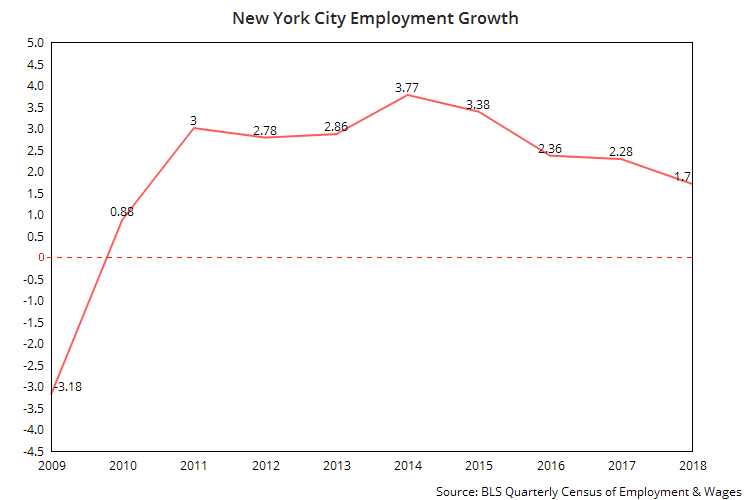New York City Minimum Wage: The minimum wages impact on jobs

Photo by ZACHARY STAINES on Unsplash
New York City recently increased its minimum wage from $13 to $15 as of 31 December 2018. In the year prior, the rate increased from $11 to $13. So in the course of two years, the minimum wage increased by 38 percent.
As the $15 minimum wage was enacted at the end of last year, the effects are still developing. However, a new study conducted by the New York City Hospitality Alliance has already found alarming results.
In a survey to 574 establishments, over 76.5 percent declared that they reduced employee hours in 2018. There was also a strong loss of jobs as 36 percent made cutbacks in 2018. That is before the minimum wage increased to $15 at the end of 2018. Going into 2019, 75 percent are looking to cut hours further, whilst 53 percent are looking to cut jobs in 2019.
New York City’s Restaurant Workers
The situation looks dire for full-service restaurant workers. Since the increase to $13, the number of workers declined by over 8,000 in one year. Perhaps unsurprisingly, restaurants have also reacted by increasing prices and reducing both staff numbers and hours.
Statistics from New York State re-enforce the negative impact that the minimum wage has had on the City of New York. Statistics may show job losses, but fail to consider the loss of potential jobs. That is to say, how many jobs would exist had the minimum wage not been enacted. For example, if the average growth between 2015 and 2017 continued, there would have been an additional 12,000 jobs created.

Higher Rents?
Perhaps higher rents are to blame for the decline. If restaurants are paying more to rent, they have other cost pressures outside of the minimum wage. The reality is that these costs have actually started to decline in recent years. For example, the average rent in Manhattan has declined by 25 percent since 2015. The market has adjusted, but other financial pressures have taken over.
Brooklyn has also started to follow suit. Its rents have seen a correction since prices plateaued in 2016. Over half of the boroughs districts have seen a decline in prices, as the market has adjusted.
Further Reading: Andrew Yang’s ‘Freedom Dividend’ doesn’t add up!
Whilst rents have started to fall, the cost of labour has increased by roughly 40 percent. This puts an unprecedented cost pressure onto restaurants and retailers alike. Restaurants for example usually allocated between 30 to 40 percent to labour costs.
Once the minimum wage kicks in, this could bring the total labour bill up to 56 percent. This is the main reason why restaurants have already started to react by reducing hours and employment. Prices have also increased somewhat, but this is a last resort in what is an extremely competitive market.
Food services and drinking places
For employment in food services and drinking places, employment growth halted once the minimum wage reached $13 at the end of 2017. In the three years prior, employment was growing by around 4.4 percent per year.
This doesn’t represent a dramatic halt in the cities economic expansion though. New York City saw an increase of 1.7% in its employment figures in 2018, only slightly down from 2.3% in 2017. However, lower job creation in minimum wage sectors can explain much of this slow down.

If employment growth continued as it did between 2013 and 2015, there would have been an additional 33,500 jobs in 2018. That figure is likely to be much higher come the end of 2019, as the $15 wage takes effect.

Retail
Retail employment in New York City has remained stagnant for the last five years. This also came at a time when it started to gradually increase the minimum wage. Retailers have very thin margins — sometimes less than 1%, with big businesses such as Walmart operating on margins below 2%. Because of such tight profit margins, the effect of the minimum wage becomes more pronounced.
The minimum wage is pushing stores towards closure as profit margins are destroyed. Already operating on thin margins, the increase to $13 has pushed many over the brink.
For the first time in over 11 years, the number of chain stores in New York City declined in 2018. In terms of employment, there has been no growth since the City started to increase the minimum wage to $8.75 in 2014. It has subsequently continued to risk to the $15 we see today. This has inevitably impacted on job creation in the city. For retail workers, if the previous job growth continued into 2014 and beyond, there would have been an additional 50,000 jobs.
Although there was not necessarily massive job losses in New York City, there have been huge declines in job growth. Essentially this is the same thing, but not so visible. Whilst the job growth in the broader City has been strong, those highly dependent minimum wage sectors have been negatively affected.
Further Reading
 Circular Flow Model - The circular flow model is a simplified representation of how money, goods, and services flow through the economy between households…
Circular Flow Model - The circular flow model is a simplified representation of how money, goods, and services flow through the economy between households…  Causes of Inflation: Cost-Push & Demand-Pull - There are three main causes of inflation. They are cost-push, demand-pull, and the velocity by which money circulates in the…
Causes of Inflation: Cost-Push & Demand-Pull - There are three main causes of inflation. They are cost-push, demand-pull, and the velocity by which money circulates in the…  Law of Diminishing Marginal Returns: Definition & Examples - Diminishing Marginal Returns occur when increasing production further results in lower levels of output.
Law of Diminishing Marginal Returns: Definition & Examples - Diminishing Marginal Returns occur when increasing production further results in lower levels of output. 